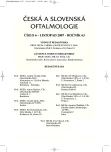-
Medical journals
- Career
Dry Eye Syndrome in Rheumatoid Arthritis Patients
Authors: V. Polanská 1; Z. Hlinomazová 1; Z. Fojtík 2; P. Němec 3
Authors‘ workplace: Oční klinika LF MU a FN, Brno přednostka prof. MUDr. Eva Vlková, CSc. 1; II. interní klinika LF MU a FN, Brno přednosta prof. MUDr. Jiří Vorlíček, CSc. 2; II. interní klinika LF MU a FN u sv. Anny, Brno přednosta doc. MUDr. Miroslav Souček, CSc. 3
Published in: Čes. a slov. Oftal., 63, 2007, No. 6, p. 422-430
Overview
The aim of this cross-sectional study was to review the incidence of the dry eye syndrome in rheumatoid arthritis (RA) patients, evaluate the association among the incidence of the dry eye syndrome, presence of positive rheumatoid factor (RF), the RA stage, and the duration of the disease. The group consisted of altogether 100 patients, 16 men and 84 women; the average age was 58.9 years (SD 14.6). The average duration of RA was 12.3 years, SD 11.0. In each patient, the Schirmer test I was performed, the presence of the LIPCOF (Lid Parallel Conjunctival Folds) on the slit lamp was assessed, the BUT (Tear Break-Up Time) was measured and vital fluorescein staining was performed. In each patient the data of the presence or absence of the RF in the serum, RA severity according to the X-ray examination, and the disease duration were recorded. The Pearson’s association test for nominal variables was used for statistical evaluation of the association between the rheumatoid arthritis presence and the dry eye syndrome. In our group of 100 patients, the Schirmer test I was positive in 67 % of patients. Positive BUT was marked in 84 % of patients. The conjunctival folds were present in 45 % of patients only. The pathological findings after cornea fluorescein staining appeared in 18 % of patients. The dry eye syndrome incidence was marked in 74 % of patients with RA. Subjective difficulties were declared by 38.3 % of patients only. The local treatment was already established in 23.0 % of patients only. We did not find statistically significant correlation between the RF positive rheumatoid arthritis appearance and dry eye syndrome, nor between the stage of the rheumatoid arthritis and presence of the dry eye syndrome. We proved statistical connection between the presence of dry eye syndrome and the duration of rheumatoid arthritis longer than 10 years. Keratoconjunctivitis sicca is the most common ocular complication in rheumatoid arthritis patients. We proved the connection between the dry eye syndrome presence and duration of the RA longer than 10 years; we did not find the dependence among the RF presence and stage of the rheumatoid arthritis and the appearance of the dry eye syndrome. The early diagnosis of the dry eye syndrome and the effective local therapy may prevent very serious corneal complications, which are difficult to treat.
Key words:
dry eye syndrome, keratoconjunctivitis sicca, rheumatoid arthritis, corneal complications.
Labels
Ophthalmology
Article was published inCzech and Slovak Ophthalmology

2007 Issue 6-
All articles in this issue
- Dry Eye Syndrome in Rheumatoid Arthritis Patients
- Diabetics in Population of Patients Treated by Pars Plana Vitrectomy
- Posterior Capsule Opacification (PCO) Following Implantation of Various Types of IOLs – Part One: The Uncomplicated Course
- Opacification of Hydrophilic Acrylic Intraocular Lenses
- Spherical Covering Foil – Silicone Implant Forming Conjunctival Fornices
- Correlation of the Heidelberg Retinal Tomograph, Evaluation of the Retinal Nerve Fiber Layer and Perimetry in the Diagnosis of Glaucoma
- Changes of the Thickness of the Ciliary Body after the Latanoprost 0.005 % Applicatio
- Czech and Slovak Ophthalmology
- Journal archive
- Current issue
- Online only
- About the journal
Most read in this issue- Opacification of Hydrophilic Acrylic Intraocular Lenses
- Dry Eye Syndrome in Rheumatoid Arthritis Patients
- Correlation of the Heidelberg Retinal Tomograph, Evaluation of the Retinal Nerve Fiber Layer and Perimetry in the Diagnosis of Glaucoma
- Posterior Capsule Opacification (PCO) Following Implantation of Various Types of IOLs – Part One: The Uncomplicated Course
Login#ADS_BOTTOM_SCRIPTS#Forgotten passwordEnter the email address that you registered with. We will send you instructions on how to set a new password.
- Career

